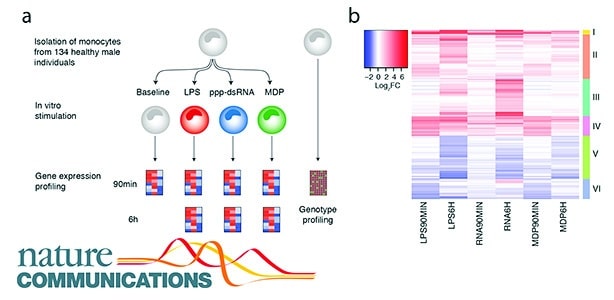Genetic Differences in Immune Response Demonstrate Interaction of Genetics and Environment Linked to Disease Risk
It is widely recognized that people respond differently to infections. This can partially be explained by genetics, shows a new study published today in Nature Communications by an international collaboration of researchers from Germany and the United States. The study, “Genetic Regulatory Effects Modified by Immune Activation Contribute to Autoimmune Disease Associations,” maps genetic variants that affect how much gene expression changes in response to immune stimulus. The findings offer novel insights into the genetic contribution to varying immune responses among individuals and its consequences on immune-mediated diseases.
“Our defense mechanisms against microbial pathogens rely on white blood cells that are specialized to detect infection. Upon encounter of microbes, these cells trigger cellular defense programs via activating and repressing the expression of hundreds of genes,” explained one of the senior authors of the study, Dr. Veit Hornung from the Ludwig-Maxmilians-Universität in Munich and formerly from the University of Bonn. “We wanted to understand how genetic differences between individuals affect this cellular response to infection,” added Dr. Johannes Schumacher from the University of Bonn, another senior author of the study.
The human immune system plays a central role in autoimmune and inflammatory diseases, cancer, metabolism and aging. The researchers discovered hundreds of genes where the response to immune stimulus depended on the genetic variants carried by the individual. “These genes include many of the well-known genes of the human immune system, demonstrating that genetic variation has an important role in how the human immune system works,” noted Dr. Sarah Kim-Hellmuth, the lead author of the study, from the New York Genome Center, Columbia University, the Max Planck Institute in Munich and formerly from the University of Bonn. “While earlier studies have mapped some of these effects, this study is particularly comprehensive, with three stimuli and two time points analyzed.”
The study captured genetic variants whose effects on gene regulation was different depending on the different infectious state of the cells. These included four associations to diseases such as cholesterol level and celiac disease. Furthermore, the researchers discovered a trend of genetic risk for autoimmune diseases such as lupus and celiac disease to be enriched for gene regulatory effects modified by the immune state. “This supports a paradigm where genetic disease risk is sometimes driven not by genetic variants causing constant cellular dysregulation, but by causing a failure to respond properly to environmental conditions such as infection,” said co-senior author Dr. Tuuli Lappalainen, from the New York Genome Center and Columbia University.
The investigators collected blood from 134 volunteers and treated monocytes – a type of white blood cells – in the laboratory with three components that mimic infection with bacteria or a virus. They then analyzed how cells from different individuals respond to infection by measuring gene expression both during the early and late immune response. Integrating the gene expression profiles with genome-wide genetic data of each individual, they were able to map how genetic variants affect gene expression, and how this genetic effect changes with immune stimulus.
“It’s been known for a long time that most diseases have both genetic and environmental risk factors. But it’s actually more complicated than that because genes and environment interact. As demonstrated in our study, a genetic risk factor may manifest only in certain environments,” explained Dr. Lappalainen. “We are still in early stages of understanding the interplay of genetics and environment, but our results indicate that this is a key component of human biology and disease. The molecular approach that we took in our study can be a particularly powerful way for researchers to delve deeper into this question.”
The study’s analyses of gene expression patterns in a population scale provide a highly robust and comprehensive dataset of innate immune responses and show wide variation among individuals exposed to diverse pathogens over multiple time points. The research identified population differences in immune response and demonstrated that immune response modifies genetic associations to disease. The research sheds light on the genomic elements underlying response to environmental stimuli, and the dynamics and evolution of immune response.
About the New York Genome Center
The New York Genome Center (NYGC) is an independent, nonprofit academic research institution at the forefront of transforming biomedical research with the mission of advancing clinical care. A collaboration of premier academic, medical and industry leaders across the globe, the New York Genome Center has as its goal translating genomic research into the development of new treatments, therapies and therapeutics against human disease. NYGC member organizations and partners are united in this unprecedented collaboration of technology, science and medicine, designed to harness the power of innovation and discoveries to advance genomic services. Their shared objective is the acceleration of medical genomics and precision medicine to benefit patients around the world. For more information, visit our website at nygenome.org.
Member institutions include: Albert Einstein College of Medicine, American Museum of Natural History, Cold Spring Harbor Laboratory, Columbia University, Hospital for Special Surgery, The Jackson Laboratory, Memorial Sloan Kettering Cancer Center, Icahn School of Medicine at Mount Sinai, NewYork-Presbyterian Hospital, The New York Stem Cell Foundation, New York University, Northwell Health, Princeton University, The Rockefeller University, Roswell Park Cancer Institute, Stony Brook University, Weill Cornell Medicine and IBM.
